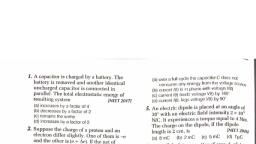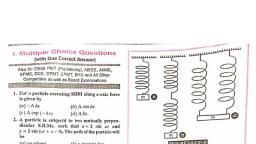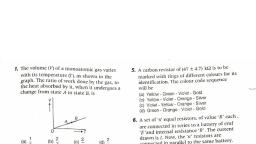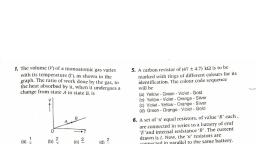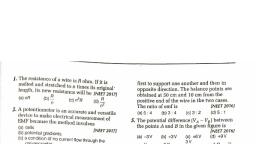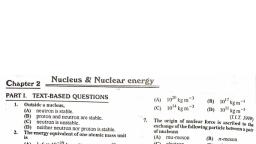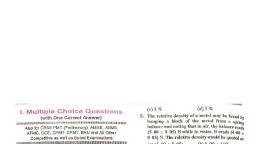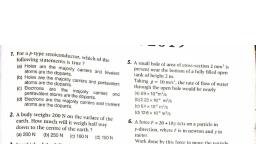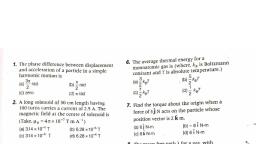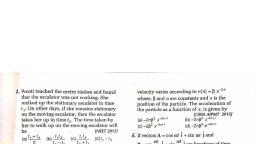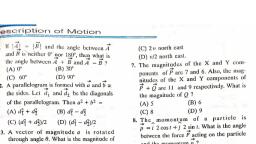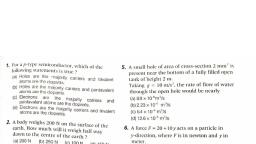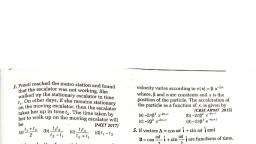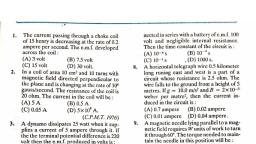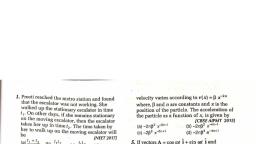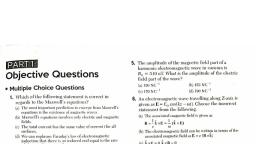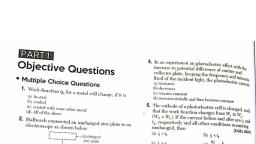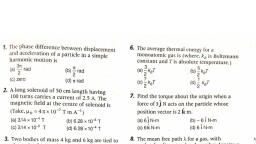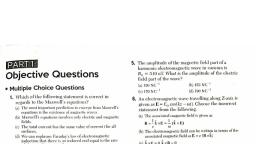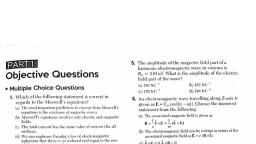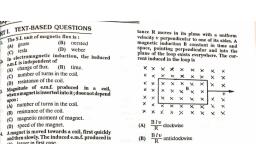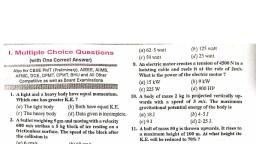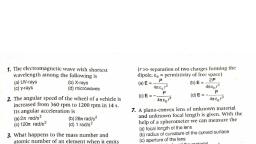Page 1 :
de ee, , 1. Multiple Choice Questions, (with One Correct Answer), Also for CBSE PMT (Pretiming,, , AFMC, DCE, DPMT, CPMT Bi) eee: AIMS,, , BHU and Ali, Competitive as well as Board Exemivetions’”, eos eRe es 4 ., , , , , , , , , , , aad 82 a, , , , , 1, A light and a heavy body have :, Which one has greater KB, ? See aeition,, , (a) The light body (6) Both have equal KB., (c) The heavy body (d) Data, 2. Abullet weighing 5 pm and m:, , oving with Hoci|, = _ ae 5 kg block of ice resting one, ictionless surface. The s if, ac cata ie peed of the block after, (a) 6 cm/s (6) 60 cm/s, (c) 6 ms (2) 0-6 cms,, , 3. Two musses of 1 gm and of 4 &™ are moving with, equal linear momenta. The ratio of their kinetic, energies is, (a)4:1 (6) v3:1, (c)1:2 (dy 1:16, , 4. Ifthe linear momentum is increased hy 50 %, then, K.E. will be increased by :, , (a) 50% (6) 100 %, (c) 125 % (d) 25 %, , §. When the K.E, ofa body is increased by 300%, the, momentum of the body is increased by, , (a) 20 % (b) 50%, (c) 100 % (d) 200 %., 6. ‘Two bodies of masses my, and my have equal K.E., ‘Their momenta shall be in the ratio of, (a)m, sm, (b) my im,, (¢) Vimy: Vin (d) ving sii, 7. When a U-238 nucleus originally at rest, decays, , by emitting an c-particle say with a speed of Vinis.,, the recoil speed (in m/s) of the residual nucteus is, , (a) Vi4 (6) -4 Vi238, (c)-4 V/234 (a) 4. V/238, , 8. A body of mass 2 kg is initially at rest. A constant, force of § N acts on it for 10 sec. Then the average., power of the force is, , given is incomplete,, , 10,, , 11., , 12., , 13., , 14., , 15., , 16, An engine develops 10 kW, , | STS ER ere ere SEAM SAE, , (a) 62-5 watt, (c) 50 watt, , (b) 125 watt, (d) 25 watt., , |. An electric motor creates a tension of 4500 N ina, , hoisting cable and reels it at the zate of 2m/s., What is the power of the electric motor ?, , (a) 1SkW (6) 9 kW, (c) 225 W (4) 900 HP, , 2 kg is projected vertically upee ae of " mjs. The maximum, gravitational potential energy of the body is, (a) 18) (b) 4-5], , (c) 9] (d) 2-251., A ball of mass 50 g is thrown upwards. It rises to, a maximum height of 100 m. At what height its, , K.E, will be reduced to 70% ?, (2) 320m (b) 40m, (c) Gm (d) 70 m., , Arod of mass mm and length / is lying§ on a horizon, tal table. Work done in making it stand on one, end will be, , {a)mgl (6) m gli, (c)img li4 (d)2mgl, , A light and a heavy body have equal K.E. Which, one has greater momentum ?, , (@) The heavy boy (b) The light body, (c) Both have equal momentum, (d) Data is incomplete., , A bullet of mass @ and yelocity b is fired into a, , large block of mass c, The final velocity of the, system is, , , , (a) zo -b (6) Ab., (c) f+ .a (d) are ib, , A long spring is streched by 2 cm. Its potential, , energy is V, Ifthe spring is stretched by 10 cm, its, potential energy would be |, , (a) Vs (b) Vis, (e)5V (d)25V i, of power. How much, , the will it take to lift a mass of 200 kg toa height, , of 40 m (¢ = 10 ms~2), , EM ANSWERS Ea
Page 2 :
POM FO-4-4m7z00, , (ar) ay (b) Sx, fe) Be (d) 105,, , 17. A hall ts deo nd from a height of, , Pped on the grow, , Im. The coef ielow! of restitution is 0-6, The, height to which the ball will rebound Is, (06m ()0-4m, (©) 036m (a) 0-16m., , IS. A force (ni? /r) iy acting on a body of mass m, moving with w velocity » ina circle of radius r., , What is the work done by the force in moving the, hody over half the circumference of the circle ?, , 2, mw, (@)——xar, , , , (b) Zero., v 2, (hm w=, mv, , 19. A body constrained to move in y-direction Is sth, Jected to a force piven by F = (- 27+ 15) + 68), N. What is the work done by this force in moving, the body through a distance of 1m along y-axis ?, (a) 1905 (b) 160), (c) 150) (d) 201., , 20. 1k = $7477 - 3% und B = 2742) -c8 ore, perpendicular vectors, the value of ¢ is, , (a) -2 (A) 8, (c)-7 (d) -8., , 21. Angle that the vector A = 27 + 39 makes with ye, axis is, , (a) tan" (3 / 2) (b) tan! (2.73), (ce) sin=! (27 3) (d) cos! (3.7 2)., , 22. ‘Two vectors x and It are such that, [A+] =~ |A-B I. Then angle between the, vectors A and if is, , (a) or (b) Gor, (c) 90° (a) 180°, (MMA), 23, The angle between the two vectors,, (= 2i + 3f+k)yand(i+2j-4k pis, (a) (hyo, (c) 180° (d) None., (C.8.5.E. PAT.), , a“, , 24, ‘The vectors F nai 4 aj + Skand, Gai-27-k are perpendicular to each, other. The positive value of a ts, , (a)3 (b)2, , (c)l (do, (E.AIC.ET. 1998), , 25. A particle moves with a velocity, T=uéindj+akm ¢ sander the influence of g, constant force, f « 207 + 15 ~ S& The instan., taneous power applied to the particle Is, (a) 35.hs~! (6) 45457!, , (c) 257s (d) S178, (C.B.S.E. P.M.T, 2009), , 26. What can be the angle between (A + 8) and, K-ie, (a) 0° only (5) 90° only, (c) 180° only (d) between 1 to 180, , 27, Consider two observers moving with respect to, each other at aspeed » along a straight line. They, observe a block of mass m moving a distance / on, a rough surface. The following quantities will be, same as observed by the two observers, (a) work done by friction, (b) acceleration of the block, (c) kinetic energy of the block at umes, (d) total work done on the block., , 28, Work done is represented by, (a) W=P x? (b+) Wasi, (c)WeP xe (We -?F, , 29. A body has its centre of mass at the origin. The, x-coordinates of the particles may be, (a) positive for some cases and negative in other, , cases, (6) all positive, (c) all negative (d) all non-negative., , 40, Fast neutrons can easily be slowed down by, (a) the use of lend shield, (6) passing them through water, (c) Blastic colts vy nucles, (d) Apply eng electric held., , 31. A particle moves along the x-axis from x = 0 to, x= Sm under the influence of a force given by, F=7~ 2x4 327, Work done in the process is, (a) 70 (b) 270, (c)35 (d) 135, , 32 A shell ts fired from a cannon with velocity, one /sutan angle @ with the horizontal direction., , At the highest point in its path, it explodes into 2, pieces of equal mass. One of the pieces retraces, , , , , , with, , , , EB ANSWERS@&
Page 3 :
yrith to the canon. The 9, other plece Homediately wfter sipheies me “a, Uy, (u) Bu cond (L)2ucn 6 io, (c) 072) cond (4) (VE 12) veang, Ig is acceleration due to uravit, face, the gain in potential vomapar : nibboheah, mass mm rained from surfiee of pls a oe, equal to cadius Roof the earth by en, (a) 1.72) mg (h) Ling, , (c) mpl (1) (1.74) mgt, Auniform chain of length Land, , onw smooth table and one lhded ort ten ae, hanging vertically down over the etlye tiban bh 2, If yg is acceleration due to Keavity, the wank ea, quired to pull the hanging part on ta the table bs, (a) Mgl. (by Mp bys, , (c) Mg LY (d) Mp Lia, , 35. The K.E. acquired by a mass mm in travelling a, , certain distance d, starting from rest, under the, , action of 4 constant force is directly proportional, to, , (aym (6) var, 1, ©) (d) none of the above., , (CBSE), . Abody, constrained to move in the y direction, is, , subject toa force F » (= i+ 15] + 6h N. What, , is the work done by this force in moving the body, , through a distance of 10m along the y-axts ?, , (a) 205 (hb) 1505, , (c) 1605 (4) 1905. (CPT), . Considers car moving along a straight horizontal, , road with a speed of 72 km/h. If the coefficient of, , static friction between road and tyres is 0-5, the, , shortest distance in which the car can be stopped, , is, , (a) 30m (b) 40m, (c)72m (d) 20m., s (Pre-Medical Dental), , . Out of a pair of identical springs of spring constunt 240 N/m, one is compressed hy 10 en and, the other is stretched by 10 cm. The difference in, potential energy stored in the two springs is, (a) Zero (yas, (c) 124 (d) 1-24. (C.P.1.T.), , If # force F applied on a bady moves it with a, velocity if, then power will be, , —~ 4 PC am, , (a) er (hy Vir, , (ey vir (ty (CPA, , an 40 ky and raving velocity 4, — pared ‘eith another object of mins GO ky, having velocity 20 Ja, Vive lows of energy when, the collision In perfectly inelastic in, (a) wes (b) 4403, (e) 44) (dj 1104., (C.P.M1), , » Inwhich case does the potential energy decreane ?, , (a) on compressing, the spring, (b) on stretching 4 “pring, (c) on muving a body against geeatational pull, (d) on the raising of an air bubble in water, (PAA.T. MP), , Adkg mass and a 1 kg mass are moving with equal, kinetic energies. The ratio of their momenta Is, (a) 1:2 (by tet, (c)2:1 (das., , (Pre-tedical Dental, 1997), , . Which of the following is not conserved in inelas, tic collision, (a) Momentum, (b) Kinetic energy, (c) Both momentum and kinetic energy, (d) Neither momentum nor kinetic energy., (CET. Chandigath 1997), , The first hall of mans m moving with the velocity, » collides head on with the second ball of muss m, ut rest. If the coefficient of restitution is ¢, then, the ratio of the velocities of the first and the, second ball after the collision is, , ws mre, w@ 5 (45, , (WEE. BHU. 1997) §, Particle A makes a perfectly elastic cellision with M, another particle Wat rest. They fly apart in op- ¢, posite direction with equal speeds, The ratio ont, , my, their masses —— is, my, , Pom =o-4, , (ayy 4
